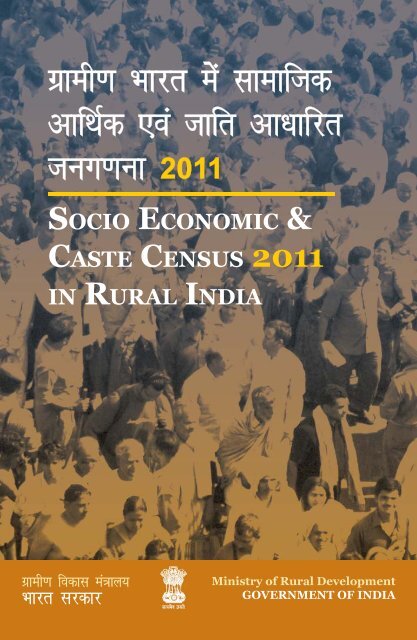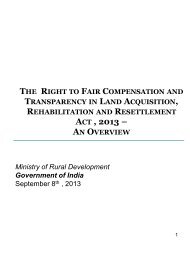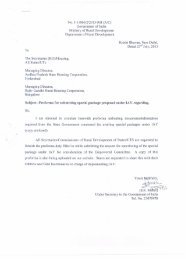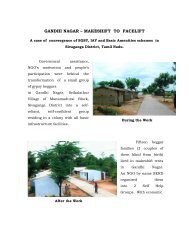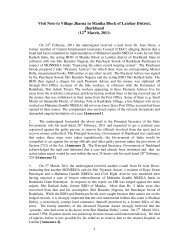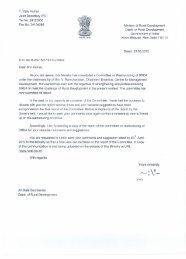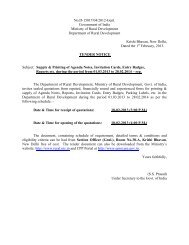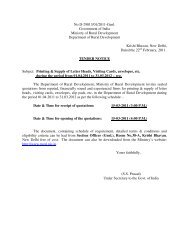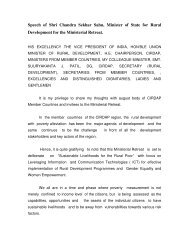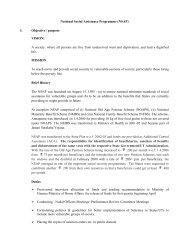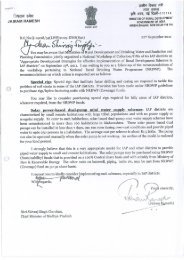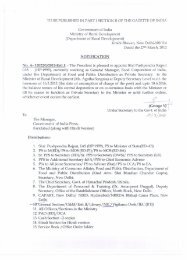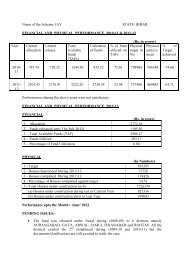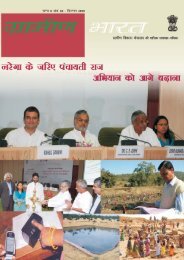Sensus Booklet Inside option 27-07-2011.indd - Ministry of Rural ...
Sensus Booklet Inside option 27-07-2011.indd - Ministry of Rural ...
Sensus Booklet Inside option 27-07-2011.indd - Ministry of Rural ...
Create successful ePaper yourself
Turn your PDF publications into a flip-book with our unique Google optimized e-Paper software.
xzkeh.k Hkkjr esa lkekftd<br />
vkfFkZd ,oa tkfr vk/kkfjr<br />
tux.kuk 2011<br />
SOCIO ECONOMIC &<br />
CASTE CENSUS 2011<br />
IN RURAL INDIA<br />
xzkeh.k fodkl ea=ky;<br />
Hkkjr ljdkj<br />
<strong>Ministry</strong> <strong>of</strong> <strong>Rural</strong> Development<br />
GOVERNMENT OF INDIA
xzkeh.k Hkkjr esa<br />
lkekftd vkfFkZd<br />
,oa tkfr vk/kkfjr<br />
tux.kuk 2011<br />
25 tqykbZ 2011<br />
xzkeh.k fodkl ea=ky;<br />
Hkkjr ljdkj<br />
1
izLrkouk<br />
ns ”k esa tkfrokj tula[;k ds vuqeku yxkus vkSj xjhch js[kk ls uhps jgus okys<br />
ifjokjksa dk irk yxkus ds laca/k esa turk dh cgqr vf/kd :fp jgh gSA xjhch js[kk<br />
ls uhps jgus okys ifjokjksa dk irk yxkus ds fy, fiNyh dk;Zokgh lu~ 2002 esa dh xbZ]<br />
ysfdu mldh dbZ lhek,a FkhA<br />
vc] xzkeh.k fodkl ea=ky;] Hkkjr ljdkj] twu] 2011 vkSj fnlEcj] 2011 ds chp<br />
lkekftd] vkfFkZd ,oa tkfr vk/kkfjr tux.kuk ¼,l-bZ-lh-lh½ 2011 dk dk;Z dj jgk<br />
gSA igyh ckj Hkkjr ds xzkeh.k vkSj “kgjh nksuksa {ks=ksa ds fy, brus cM+s iSekus ij dk;ZokbZ<br />
dh tk jgh gSA<br />
,l-bZ-lh-lh- 2011 ds fuEufyf[kr rhu mÌs”; gSa%&<br />
1. ?kj&?kj tkdj lkekftd&vkfFkZd x.kuk djuk ftlls ifjokjksa dh<br />
lkekftd&vkfFkZd fLFkfr ds vk/kkj ij muds Lrj dk irk yx tk,xkA<br />
rc jkT; ljdkjsa xjhch&js[kk ls uhps jgus okys ifjokjksa dh lwph rS;kj dj<br />
ldsaxhA<br />
2. izkekf.kd lwpuk miyC/k djkuk] ftlls ns”k dh tkfrokj tula[;k dh x.kuk gks<br />
ldsA<br />
3. f<strong>of</strong>HkUu tkfr;ksa dh lkekftd&vkfFkZd fLFkfr vkSj f<strong>of</strong>HkUu tkfr;ksa vkSj tula[;k ds<br />
f<strong>of</strong>HkUu oxksZa dh “kS{kf.kd fLFkfr ds laca/k esa izkekf.kd lwpuk miyC/k djkukA<br />
2002 ds ch-ih-,y- losZ{k.k dh dfe;ksa ij ,l-bZ-lh-lh- 2011 esa foLr`r :i ls /;ku<br />
fn;k tk jgk gSA ,l-bZ-lh-lh- 2011 esa%&<br />
� lkjk dk;Z fcuk dkxt&i= ds gS.MgsYM bysDVªksfud fMokbt+<br />
¼VscysV ih-lh-½ ij fd;k tk,xkA blls vkadM+k izf<strong>of</strong>’V esa xyfr;k¡ vkSj<br />
izx.kd ds L<strong>of</strong>u.kZ; esa cgqr vf/kd deh vk,xhA<br />
� lkjh lwpuk iw.kZr% vk/kkj vkSj ,u-ih-vkj ds vuqdwy gksxhA<br />
2
� ;g lqfuf”pr~ djus ds fy, fd fdlh izdkj dh xyr lwpuk u nh tk,]<br />
x.kuk pj.k ls xzke lHkk ds Lrj ij turk }kjk tk¡p& lHkh Lrjksa ij tk¡p<br />
iM+rky dh O;oLFkk dh xbZ gSA<br />
� vf/kdka”k tkudkjh lkoZtfud :i ls miyC/k djk;h tk,xhA<br />
bl iqfLrdk esa ,l-bZ-lh-lh- 2011 dks <strong>of</strong>.kZr fd;k x;k gSA pw¡fd] ;g xzkeh.k Hkkjr ls<br />
lacaf/kr gS] vr% blesa lk/kkj.k Hkk’kk esa iwjh dk;Zokgh fufnZ’V dh xbZ gSA<br />
3<br />
t;jke jes”k<br />
t;jke jes”k<br />
xzkeh.k fodkl ea=h<br />
Hkkjr ljdkj
izk;% iwNs tkus okys iz”u<br />
1. lkekftd vkfFkZd ,oa tkfr vk/kkfjr tux.kuk 2011 D;k gS\<br />
Hkkjr ljdkj }kjk ns”k Hkj ds ifjokjksa ls lacaf/kr lkekftd vkfFkZd ladsrdksa dh fo”kky<br />
la[;k ij tkudkjh ,d= djus ds fy, lkekftd vkfFkZd ,oa tkfr vk/kkfjr tux.kuk<br />
2011 djkbZ tk jgh gSA blds rhu egRoiw.kZ ifj.kke gkasxs%<br />
� igyk] lkekftd vkfFkZd ,oa tkfr vk/kkfjr tux.kuk 2011 ifjokjksa dks<br />
mudh lkekftd vkfFkZd fLFkfr ds vk/kkj ij jSad iznku djsxh ftlls<br />
jkT;@la?k jkT;{ks= ljdkjsa ;FkkFkZ :i ls xzkeh.k rFkk “kgjh {ks=ksa esa xjhch js[kk ls<br />
uhps jg jgs ifjokjksa dh ,d lwph rS;kj dj ldsxhA<br />
� nwljk] blls ns”k esa tula[;k ds tkfrokj C;ksjksa dh izekf.kd tkudkjh miyC/k gks<br />
ldsxhA<br />
� rhljk] ;g f<strong>of</strong>HkUu tkfr;ksa dk lkekftd vkfFkZd fooj.k iznku djsxhA<br />
lkekftd vkfFkZd ,oa tkfr vk/kkfjr tux.kuk 2011 Hkkjr ljdkj ds rduhdh rFkk foRrh;<br />
lg;ksx ds lkFk jkT; ljdkj rFkk la?k jkT;{ks= iz”kklu }kjk xzkeh.k rFkk “kgjh {ks=ksa ds<br />
fy, ,d lkFk vk;ksftr dh tk jgh gSA<br />
2. lkekftd vkfFkZd ,oa tkfr vk/kkfjr tux.kuk 2011 D;ksa djkbZ tk jgh<br />
gS\<br />
� lkekftd vkfFkZd ,oa tkfr vk/kkfjr tux.kuk 2011 ifjokjkas dks mudh lkekftd<br />
vkfFkZd fLFkfr ds vk/kkj ij ;FkkFkZr% ls jSad iznku djsxh tks fd xjhch dh js[kk ls<br />
uhps jg jgs ifjokjksa dh igpku dk vk/kkj gksxkA<br />
4
� blls ljdkjh ;kstukvksa dks lgh ykHkkFkhZ rd igq¡pkus esa lgk;rk feysxh vkSj ;g<br />
lqfuf”pr gksxk fd lHkh lqik= ykHkkfFkZ;ksa dks ykHk igq¡ps rFkk vik= ykHkkFkhZ budk ykHk<br />
ugha ys ik,aA<br />
� vR;f/kd oafpr ds :i esa igpkus x, ifjokjksa dks ljdkjh dY;k.k ;kstukvksa ds varxZr<br />
lokZf/kd izkFkfedrk ds lkFk “kkfey fd;k tk,xkA<br />
� xjhch js[kk ls uhps jg jgs yksxksa dh igpku dk dk;Z fiNyh ckj lu~ 2002 esa fd;k<br />
x;k FkkA blls feyh lh[k ds vk/kkj ij dk;Z i)fr dks O;kid :i ls la”kksf/kr<br />
fd;k x;k rkfd lEiw.kZ dojst] lqfuf”pr ikjnf”kZrk vkSj lkekftd vkfFkZd iSekuksa ds<br />
vk/kkj ij ifjokjksa dh igpku dk mÌs”; izkIr fd;k tk ldsA<br />
3. lkekftd vkfFkZd ,oa tkfr vk/kkfjr tux.kuk 2011 dc izkjaHk gksxh\<br />
� lkekftd vkfFkZd ,oa tkfr vk/kkfjr tux.kuk] twu] 2011 vkSj 31 fnlEcj] 2011<br />
ds e/; vk;ksftr dh tk jgh gSA<br />
� bls 29 twu] 2011 dks if”peh f=iqjk ds gktheksjk [kaM esa “kq: fd;k x;k Fkk<br />
4. lkekftd vkfFkZd ,oa tkfr vk/kkfjr tux.kuk 2011 vkSj ;kstuk vk;ksx<br />
}kjk yxk, x, xjhch vuqekuksa esa D;k vraj gS\<br />
;kstuk vk;ksx f<strong>of</strong>HkUu jkT;ksa@la?k jkT;{ks=ksa esa xjhch js[kk ls uhps jg jgh xzkeh.k rFkk “kgjh<br />
tula[;k dh izfr”krrk ds vuqeku miyC/k djkrk gSA vFkkZr~ ;g vuqeku yxkrk gS fd<br />
xjhch “fdruh” gSA nwljh vksj lkekftd vkfFkZd ,oa tkfr vk/kkfjr tux.kuk 2011 ;g<br />
tkudkjh iznku djsxh fd “dkSu” lh tula[;k xjhch js[kk ls uhps jg jgh gSA bl izdkj<br />
mnkgj.k ds fy,] fdlh jkT; ds laca/k esa ;kstuk vk;ksx ds tula[;k ds xjhch dh js[kk ls<br />
uhps jg jgs vuqeku xzkeh.k tula[;k ds fy, 55% vkSj “kgjh tula[;k ds fy, 30% gks<br />
ldrs gSaA lkekftd vkfFkZd ,oa tkfr vk/kkfjr tux.kuk 2011 ;g igpku djus esa leFkZ<br />
cuk;sxh fd fdlh f<strong>of</strong>”k’V jkT; esa dkSu ls ifjokj Øe”k% 55% vkSj 30% esa “kkfey gSaA<br />
5
5. D;k lkekftd vkfFkZd ,oa tkfr vk/kkfjr tux.kuk 2011<br />
dh dk;Z i)fr dk izk;ksfxd rkSj ij ijh{k.k fd;k x;k<br />
gS\<br />
xzkeh.k {ks=% xzkeh.k {ks=ksa dh dk;Z i)fr dks f<strong>of</strong>HkUu dk;Z i)fr;ksa ds QhYM ijh{k.kksa ds<br />
mijkar vfUre :i fn;k x;k gS( vkSj blds fy, “lDlsuk lDlsuk fo”ks’kK lewg dh flQkfj”kk flQkfj”kksa”<br />
dk lanHkZ ds RkkSj ij iz;ksx fd;k x;k gSA QhYM ijh{k.k nks pj.k esa fd, x, FksA igyk]<br />
,d lajfpr iz”ukoyh dk iz;ksx dj 254 xkaoksa dh lkekftd vkfFkZd tux.kuk dh xbZ<br />
FkhA nwljk] vusd vuqdwyre ekunaMksa ds vuqlkj mlh xkao esa ifjokj dks jSad nsus ds fy,<br />
,d lgHkkxh xzkeh.k ewY;kadu rduhd mi;ksx esa ykbZ xbZ FkhA 43,000 xzkeh.k ifjokjksa dks<br />
doj dj jgs 29 jkT;ksa esa QSys 161 xkaoksa dss ifj.kkeksa dks xzkeh.k {ks=ksa ds fy, lkekftd<br />
vkfFkZd ,oa tkfr vk/kkfjr tux.kuk 2011 esa ekinaM dks vafre :i nsus ds fy, mi;ksx<br />
esa yk;k x;kA<br />
“kgjh {ks=% ;kstuk vk;ksx us “kgjh {ks=ksa esa lkekftd vkfFkZd ,oa tkfr<br />
vk/kkfjr tux.kuk ds vk;kstu gsrq dk;Z i)fr dks vfHkKkr djus ds fy, gkf”ke<br />
lfefr fo”ks’kK lewg dh fu;qfDr dhA blls izkIr vkadM+ksa dk fo”kys’k.k fd;k tk,xk<br />
vkSj blds vk/kkj ij ;g lfefr “kgjh {ks=ksa esa xjhc ifjokjksa dh igpku djus dh dk;Z<br />
i)fr Kkr djsxhA<br />
6. xzkeh.k {ks=ksa esa lkekftd vkfFkZd ,oa tkfr vk/kkfjr tux.kuk 2011 ds<br />
vk;kstu dh izfØ;k D;k gS\<br />
lkekftd vkfFkZd ,oa tkfr vk/kkfjr tux.kuk 2011 ,d O;kid dk;ZØe ds ek/;e ls<br />
xzkeh.k fodkl ea=ky;] vkokl rFkk “kgjh xjhch mUewyu ea=ky;] Hkkjr ds egkjftLVªkj<br />
,oa tux.kuk vk;qDr dk dk;kZy; vkSj jkT; ljdkj dks “kkfey dj vk;ksftr dh tk,xhA<br />
;g izfØ;k fuEuor~ gS%<br />
� izR;sd dySDVj@ftyk eftLVªsV ,d ftyk@uxj ;kstuk vkSj ,d laizs’k.k ;kstuk rS;kj<br />
djsxkA<br />
� lkekftd vkfFkZd ,oa tkfr vk/kkfjr tux.kuk 2011 ds fy, 24 yk[k x.kuk Cykdksa<br />
dk mi;ksx fd;k tk,xk&izR;sd x.kuk CykWd esa vuqekur% 125 ifjokj gSaA ;s ogh x.kuk<br />
CykWd gSa tks fd tux.kuk 2011 ds nkSjku cuk, x, FksA izx.kdksa dks tux.kuk 2011<br />
6
ds nkSjku rS;kj ekufp= rFkk laf{kIr edkulwph dh izfr;ka miyC/k djkbZ tk,axhA blls<br />
{ks= dk lEiw.kZ dojst lqfuf”pr gksxkA<br />
� lkekftd vkfFkZd ,oa tkfr vk/kkfjr tux.kuk 2011 ds fy, izx.kdksa dks izf”kf{kr<br />
fd;k tk,xkA<br />
� izR;sd izx.kd dks pkj x.kuk CykWd fn, tk,axs vkSj izR;sd 6 izx.kdksa ij ,d i;Zos{kd<br />
gksxkA<br />
� izx.kd x.kuk CykWd esa vfHkKkr izR;sd ifjokj dk nkSjk djsxk vkSj iz”ukoyh dks HkjsxkA<br />
os cs?kj tula[;k ¼mnkgj.kkFkZ jsyos LVs”ku] lM+d ds fdukjs] vkfn LFkkuksa ij jg jgs<br />
yksx½ ds ikl Hkh tk,axsA<br />
� izR;sd izx.kd ds lkFk ,d MkVk ,UVªh vkWijsVj jgsxkA<br />
� ;g MkVk ,d bysDVªkfud gSUM gsYM fMokbl ¼,d VscysV ihlh½ esa<br />
lh/ks fy;k tk,xkA gSUM gsYM fMokbl esa jk’Vªh; tula[;k jftLVj gsrq Hkjs x, QkeksZa<br />
dh LdSu best izfo’V gksaxhA blls Hkh lEiw.kZ rFkk ;Fks’V dojst lqfuf”pr~ gksxhA<br />
� tkudkjh ¼VscysV ihlh esa lekfo’V½ mÙkjnkrk dks i
7. ;g izfØ;k xzkeh.k {ks=ksa esa fdl izdkj vH;kl esa ykbZ tk,sxh\<br />
izx.kd x.kuk CykWd ds izR;sd ifjokj ls iz”u iwNuk<br />
x.kuk CykWd ds vkadM+kas dks ,d= djuk<br />
lkekftd vkfFkZd ekudksa ds vk/kkj ij Lor% gh lwph ls gVk, tkus oky okys ifjokjksa dh<br />
igpku dh tk ldsxh<br />
lkekftd vkfFkZd ekudksa ds vk/kkj ij Lor% gh lwph esa “kkfey fd, tkus oky okys ifjokjksa<br />
dh igpku dh tk ldsxh<br />
“ks’k ifjokjksa ds oapu dk ewY;kadu djuk<br />
Lor% “kkfey gksus vkSj oapd dkjdksa ds vk/kkj ij ifjokjksa dks jSad nsuk<br />
jkT; Lrjh; jSafdx rS;kj djuk<br />
jSafdx fyLV dks jkT; ljdkjksa dks lkSaiuk<br />
N=d ds :i esa jkT; ljdkjksa }kjk ;kstuk vk;ksx ds xjhch ds vuqekuksa dk mi;ksx<br />
8
8. xzkeh.k {ks=ksa esa ifjokjksa dks fdl izdkj jSad fn;k tk,xk\<br />
ifjokjksa dks rhu Lrjh; izfØ;k }kjk jSad fn;k tk,xk<br />
a. ifjokjksa dk ,d lewg Lor% vyx gks tk,xk<br />
fuEufyf[kr esa ls cus fdlh Hkh ,d ds /kkjd ifjokj Lor% vyx gks tk;saxsa%<br />
� eksVj pkfyr nksifg;k@frifg;k@pkj ifg;ksa okys okgu@eNyh idM+us dh ukoA<br />
� e”khu pkfyr rhu@pkj ifg;ksa okys —f’k midj.kA<br />
�<br />
50 gtkj vkSj blls vf/kd dh ekud lhek ds fdlku ØsfMV dkMZA<br />
� ljdkjh lsod okys fdlh lnL; ds ifjokjA<br />
� ljdkj esa iath—r xSj&—f’k m|ksx okys ifjokjA<br />
� ifjokj dk dksbZ lnL; 10,000 :i, izfr ekl ls vf/kd dekrk gSA<br />
� vk;dj vnk djrs gSaA<br />
� O;kolkf;d dj vnk djrs gSA<br />
� lHkh dejksa esa iDdh nhokjsa vkSj Nr ds lkFk rhu vFkok vf/kd dejsA<br />
� jsfQztjsVj gSA<br />
� ySaMykbu Qksu gSA<br />
� de ls de 1 flapkbZ midj.k ds lkFk 2.5 ,dM+ vFkok blls vf/kd flafpr Hkwfe gSA<br />
� nks vFkok mlls vf/kd Qly ds ekSle ds fy, 5 ,dM+ vFkok blls vf/kd flafpr Hkwfe gSA<br />
� de ls de ,d flapkbZ midj.k ds lkFk de ls de 7.5 ,dM+ vFkok blls vf/kd Hkwfe gSA<br />
b. ifjokjksa dk ,d lewg Lor% 'kkfey gks tk,xk<br />
fuEufyf[kr fLFkfr okyk ifjokj Lor% 'kkfey gks tk;sxk%<br />
� cs?kj ifjokj<br />
� fujkfJr@fHk{kqd<br />
� eSyk
c- ckdh cps ifjokjksa dks lkr oapu lwpdkadks dk iz;ksx djrs gq, jSad fn;k tk,xkA<br />
lcls vf/kd oapu Ldksj okys ifjokj dks xjhch js[kk ls uhps okys ifjokjksa dh lwph<br />
esa 'kkfey djus ds fy, lcls mPp izkFkfedrk nh tk,xhA<br />
fuEufyf[kr oapu lwpdkad gSa%<br />
� dPph nhokjksa vkSj dPph Nr ds lkFk dsoy ,d dejs esa jgus okys ifjokjA<br />
� ifjokj esa 16 ls 59 o’kZ ds chp dh vk;q dk dksbZ o;Ld lnL; ugha gSA<br />
� efgyk eqf[k;k okys ifjokj ftlesa 16 ls 59 o’kZ ds chp dh vk;q dk dksbZ o;Ld iq:’k<br />
lnL; ugha gSA<br />
� fu%”kDr lnL; okys vkSj fdlh l{ke “kjhj okys o;Ld lnL; ls jfgr ifjokjA<br />
� vuq-tk-@vuq-t-tk- ifjokj<br />
� ,sls ifjokj tgka 25 o’kZ ls vf/kd vk;q dk dksbZ o;Ld lk{kj ugha gSA<br />
� Hkwfeghu ifjokj tks viuh T;knkrj dekbZ fngkM+h etnwjh ls izkIr djrs gSaA<br />
9. xzkeh.k {ks=ksa esa tkudkjh dkSu ,df=r djsxk\<br />
� izR;sd x.kuk CykWd esa jkT; ljdkj }kjk fu;qDr izx.kd ;g dk;Z djsxkA mlds lkFk<br />
,d MkVk ,aVªh vkijsVj gksxkA<br />
� izx.kd vius lkFk jkT; izkf/kdkjh }kjk tkjh viuk fu;qfDr izek.k&i= vkSj igpku<br />
i= ysdj vk,xkA<br />
� blds vykok] O;fDrxr foosdkf/kdkj dh dksbZ laHkkouk u NksM+rs gq,<br />
izx.kd ds lkFk xzke iapk;r] xzke lHkk dk izfrfuf/k vkSj dksbZ vU; ukxfjd gks ldrk<br />
gS rkfd vkadM+s fu’i{k vkSj ikjn”khZ rjhds ls ,df=r fd;s tkus lqfuf”pr~ gksaA<br />
� ;g /;ku nsa fd f”k{kk dk vf/kdkj vf/kfu;e] 2009 }kjk izfrca/k yxk;s tkus ds dkj.k<br />
bl iz;kstu ds fy, izkFkfed fo|ky; f”k{kdksa dh lsok;sa izkIr ugha dh tk ldrh gSaA<br />
10
10. tkudkjh fdl izdkj ,df=r dh tk,xh\<br />
� izx.kd vius ikl j[kh iz”ukoyh esa ls mÙkjnkrk ls iz”u iwNsxkA MkVk ,aVªh vkijsVj<br />
mu mÙkjksa dks gLrpkfyr bySDVªkfud midj.k ¼VscysV ih-lh-½ esa ntZ djsxkA<br />
� mÙkjnkrk dks vius }kjk nh tk jgh tkudkjh ds leFkZu esa dksbZ nLrkost+h lk{; ugha<br />
fn[kkuk gSA rFkkfi] mÙkjnkrk ls ;g vis{kk dh tkrh gS fd og lgh vkSj izekf.kd<br />
tkudkjh ns ftldk izx.kd }kjk lR;kiu fd;k tk ldrk gSA<br />
� vkadM+s ,d=.k dk dk;Z iwjk gks tkus ds ckn izx.kd vius vkSj MkVk ,UVªh vkijsVj<br />
}kjk gLrk{kfjr ikorh jlhn mÙkjnkrk dks nsxkA<br />
� izx.kd mÙkjnkrk ds edku dh ckgjh nhokj ij LVhdj fpidk;sxkA<br />
11. xzkeh.k {ks=ksa esa fdl rjg dh tkudkjh ,df=r dh tk,xh\<br />
tkudkjh O;fDr vkSj ifjokj ds lanHkZ esa ,df=r dh tk,xh ftlesa fuEufyf[kr “kkfey<br />
gS%&<br />
� O;olk;<br />
� f”k{kk<br />
� fu%”kDrrk<br />
� /keZ<br />
� vuq-tk-@vuq-t-tk- fLFkfr<br />
� tkfr@tutkfr dk uke<br />
� jkst+xkj<br />
� vk; vkSj vk; dk lk/ku<br />
� ifjlEifÙk;k¡<br />
� edku<br />
� fVdkÅ vkSj xSj&fVdkÅ miHkksDrk lkeku<br />
� Hkwfe<br />
11
12. xzkeh.k {ks=ksa esa dkSu ls vkadM+s miyC/k djk;s tk;saxs vkSj dgk¡ ij\<br />
elkSnk izdk”ku lwph dk eqnz.k djus ds i”pkr~ ifjokj }kjk vius /keZ vkSj tkfr ds uke<br />
ds ckjs esa nh xbZ tkudkjh dks NksM+dj vU; lHkh vkadM+s] xzkelHkk vkSj iapk;r esa i
� EklkSnk lwph ds izdk”ku ds ,d lIrkg ds Hkhrj xzke lHkk dh cSBd dh tk,xhA xzke<br />
lHkk dh cSBd esa izR;sd ifjokj ds uke vkSj mÙkj Ik
lkekftd vkfFkZd ,oa tkfr vk/kkfjr tux.kuk ¼,l-bZ-lh-lh-½ 2011 2011] ] ch-ih-<br />
,y tux.kuk 2002 ls fdl izdkj csgrj gS\ gS<br />
1. mi;ksx esa yk,<br />
x, ekin.M<br />
2. vkdM+ks dk<br />
lR;kiu vkSj turk<br />
}kjk tkap<br />
ch-ih-,y- 2002 ,l-bZ-lh-lh- 2011 ch-ih-,y- 2002 ds lUnHkZ es<br />
yk, x, uokpkj<br />
13 lkekftd&vkfFkZd<br />
lwpdkadks ds lkFk igpkuh<br />
xbZ ch-ih-,y- tula[;k<br />
ds ifj.kkeksa esa =qfV;ksa dk<br />
cgqr vf/kd lfEeyu vkSj<br />
viotZu jgkA<br />
tkudkjh dks turk ls<br />
lR;kfir ugha djk;k x;kA<br />
3. Ldksj i)fr 52 fcUnqvksa dh tfVy<br />
i)fr<br />
4. eSuqvy cuke<br />
bySDVªksfud<br />
5. ,df=r vkadM+ks<br />
dh mi;ksfxrk<br />
6. tux.kuk dk<br />
izdkj<br />
vkdM+ksa dh izf<strong>of</strong>’V Nis<br />
QkeksZa ls gkFk ls dh xbZ<br />
dk;ZØe dh e/;LFkrk gsrq<br />
f<strong>of</strong>HkUu ea=ky;ksa dks vkadM+s<br />
miyC/k ugha djk, x,<br />
2002 dk ch- ih- ,y-<br />
,dy :Ik esa fd;k x;k<br />
ch-ih-,y- tula[;k dks<br />
igpkuus okys ds fy,<br />
mi;ksx esa yk;s tk jgs<br />
ekun.M ds 3 ?kVd gS%<br />
Lor% viotZu<br />
Lor% lfEeyu vkSj lkr<br />
oapu lwpdkadksa ds vk/kkj<br />
ij jSfdaxA<br />
x.kuk Lrj ij i;Zos{kd]<br />
xzke lHkk vkSj jkT;<br />
ljdkj ds vU; dk;kZy;ksa<br />
}kjk lR;kiu<br />
vklku i)fr ds lkFk<br />
oxhZdj.k ds 4 rjhds<br />
gSaMgsYM bysDVªksfud fMokbZl<br />
¼VscysV ih-lh-½ ls vkdM+ksa<br />
dh lh/kh izf<strong>of</strong>’V<br />
vkadM+ks dk ,e- vkbZ-<br />
,l- esa izn”kZu] vk/kkj ,oa<br />
,u- ih- vkj- ds lkFk<br />
iwjh rjg vuqdqy] f<strong>of</strong>HkUu<br />
ea=ky;ksa] jkT;ksa] ih- vkj-<br />
vkbZ- ,oa ukxfjdksa ds<br />
mi;ksx ds fy, lqyHk<br />
,l- bZ- lh- lh- 2011<br />
xzkeh.k ,oa uxjh; {ks=ksa ds<br />
fy, la;qDr :i ls tkfr<br />
dh x.kuk ds lkaFk fd;k tk<br />
jgk gSA<br />
14<br />
lfEeyu@viotZu dh lhek js[kk<br />
dks dkQh gn rd de dj fn;k<br />
x;k gS%<br />
� Lor% viotZu dk ekun.M<br />
vik= ifjokjksa ds ch-ih-<br />
,y- lwph esa izos”k ikus dh<br />
lEHkkouk dks de djrk gSA<br />
� Lor% lfEeyu dk ekun.M<br />
lcls ik= ifjokjksa ds ch-ih-<br />
,y- lwph esa “kkfey gksus dh<br />
lEHkkouk dks c<br />
ldrs gS%<br />
vklkuh ls dk;kZfUor fd;k tk<br />
ldrk gS vklkuh ls lR;kiu]<br />
izx.kd dh viuh le> dk de<br />
bLrseky] ch-ih-,y-<br />
tux.kuk 2002 esa iz;ksx esa yk,<br />
x, f<strong>of</strong>”k’V<br />
lqfo/kkvksa ¼tSls “kkSpky; bR;kfn ½<br />
vk/kkfjr ekun.M dk mi;ksx ugha<br />
fd;k tkrkA<br />
dkxt&eqDr i)fr n{krk c
lkekftd&vkfFkZd ,oa tkfr vk/kkfjr tux.kuk 2011<br />
ds fy, Hkkjr bySDVªkWfuDl fyfeVsM<br />
}kjk fodflr y?kq gLrpkfyr midj.k ¼ih-lh-½<br />
eq[; fo”ks’krk,¡<br />
� izHkkoh x.kuk dk lk/ku rFkk miyC/k midj.k<br />
� bldk otu 1 fd-xzk- gS rFkk bls gLrpkfyr midj.k ds :i esa dgha Hkh<br />
ys tk;k tk ldrk gS<br />
� 7 bap ,y-lh-Mh- jaxhu fMLIys<br />
� Vp LØhu] usfoxs”ku&dh rFkk dh&cksMZ<br />
� bZFkjusV ds ek/;e ls baVjusV laidZrk] 2 ;w-,l-ch- iksVZ<br />
� blds f<strong>of</strong>o/k dk;ksZa esa lksyj cSVjh dk mi;ksx fd;k tk ldrk gSA<br />
15
SOCIO<br />
ECONOMIC &<br />
CASTE CENSUS<br />
2011<br />
IN RURAL INDIA<br />
25 th July 2011<br />
<strong>Ministry</strong> <strong>of</strong> <strong>Rural</strong> Development<br />
GOVERNMENT OF INDIA<br />
17
Foreword<br />
There has been extensive public interest in estimating caste-wise<br />
population in the country, and on identifying households living<br />
below the poverty line. The last exercise to identify people living in<br />
poverty was conducted in 2002, but had several limitations.<br />
The <strong>Ministry</strong> <strong>of</strong> <strong>Rural</strong> Development Government <strong>of</strong> India, is now<br />
carrying out the Socio Economic and Caste Census (SECC) 2011,<br />
between June 2011 and December 2011, through a comprehensive<br />
door to door enumeration across the country. This is the fi rst time<br />
such a comprehensive exercise is being carried out for both rural<br />
and urban India.<br />
The SECC, 2011 has the following three objectives:<br />
1. To enable households to be ranked based on their socioeconomic<br />
status. State Governments can then prepare a list <strong>of</strong><br />
families living below the poverty line<br />
2. To make available authentic information that will enable castewise<br />
population enumeration <strong>of</strong> the country<br />
3. To make available authentic information regarding the socioeconomic<br />
condition, and education status <strong>of</strong> various castes and<br />
sections <strong>of</strong> the population<br />
The shortcomings <strong>of</strong> the 2002 BPL survey are being addressed<br />
comprehensively in the SECC, 2011:<br />
� The entire exercise will be paperless, done on a handheld<br />
electronic device (tablet PC). This will drastically reduce data<br />
entry errors and enumerator discretion<br />
18
� Checks and balances at several levels - from the enumeration<br />
stage, to public scrutiny at the Gram Sabha level – will ensure<br />
that there is no misreporting<br />
� Almost all <strong>of</strong> the information will be made available in the public<br />
domain<br />
This booklet explains the SECC,2011, as it relates to rural India,<br />
and details the entire process in simple language<br />
19<br />
Jairam Ramesh<br />
Minister <strong>of</strong> <strong>Rural</strong> Development<br />
Government <strong>of</strong> India
Frequently Asked Questions<br />
(FAQs)<br />
1. What is the Socio Economic and Caste Census<br />
(SECC) 2011?<br />
The Socio Economic and Caste Census (SECC), 2011 is being carried<br />
out by the Government <strong>of</strong> India to generate information on a large<br />
number <strong>of</strong> social and economic indicators relating to households<br />
across the country. It will have three important outcomes:<br />
� Firstly, the SECC, 2011 will rank households based on their socioeconomic<br />
status, so that State/Union Territory Governments<br />
can objectively prepare a list <strong>of</strong> families living below the poverty<br />
line in rural and urban areas<br />
� Secondly, it will make available authentic information on the<br />
caste-wise breakup <strong>of</strong> population in the country<br />
� Thirdly, it will provide the socio-economic pr<strong>of</strong>i le <strong>of</strong> various<br />
castes<br />
The SECC, 2011 is being conducted simultaneously for rural<br />
and urban areas, by the respective State Government and Union<br />
Territory Administration, with technical and fi nancial support from<br />
the Government <strong>of</strong> India.<br />
2. Why is the SECC, 2011 being carried out?<br />
� The SECC, 2011 will objectively rank households based on<br />
their socio-economic status, which would be the basis for<br />
identifi cation <strong>of</strong> households living below the poverty line<br />
20
� This exercise will help to better target government schemes to<br />
the right benefi ciaries, and ensure that all eligible benefi ciaries<br />
are covered, while all ineligible benefi ciaries are excluded<br />
� Households identifi ed as highly deprived will have the highest<br />
inclusion priority under Government welfare schemes<br />
� The last exercise to identify people living below the poverty line<br />
was conducted in 2002. Based on the learning from this exercise<br />
the methodology has been comprehensively revised to ensure<br />
complete coverage, transparency and objective identifi cation <strong>of</strong><br />
households based on socio economic parameters.<br />
3. When will the SECC, 2011 take place?<br />
� The SECC, 2011 is being conducted between June 2011 and 31 st<br />
December 2011<br />
� It was launched on 29 th June 2011 in Hazemora Block in West<br />
Tripura<br />
4. What is the difference between SECC, 2011 and the<br />
Planning Commission estimates <strong>of</strong> poverty?<br />
The Planning Commission provides estimates <strong>of</strong> the percentage<br />
<strong>of</strong> the rural and urban population living below the poverty line in<br />
different States/UTs. That is, it estimates the “how much” <strong>of</strong> poverty.<br />
The SECC, 2011 on the other hand, will provide information on the<br />
“who” <strong>of</strong> the population living below the poverty line. Thus, for<br />
example, the Planning Commission estimate for a State could<br />
be that say 55% <strong>of</strong> the rural population and say 30% <strong>of</strong> the urban<br />
population is living below the poverty line. SECC, 2011 will enable<br />
that particular State to identify the households who comprise this<br />
55% and 30% respectively.<br />
21
5. Has the SECC, 2011 methodology been pilot<br />
tested?<br />
<strong>Rural</strong> areas: The methodology for rural areas has been<br />
fi nalized after fi eld testing several methodologies; and using the<br />
recommendations <strong>of</strong> the Saxena Expert Group as the reference<br />
point. The fi eld testing was carried out in two stages. First, a<br />
socio-economic census <strong>of</strong> 254 villages was conducted using a<br />
structured questionnaire. Second, a participatory rural appraisal<br />
(PRA) technique was used to rank households in the same village<br />
according to several well-being criteria. The results <strong>of</strong> 161 villages<br />
spread over 29 states, covering 43,000 rural households have been<br />
used to fi nalize the criteria used in the SECC, 2011 for rural areas.<br />
Urban areas: The Planning Commission appointed the Hashim<br />
Committee Expert Group to identify the methodology to conduct<br />
the SECC in urban areas. The data generated will be analyzed, and<br />
on the basis <strong>of</strong> this, the Committee will determine the methodology<br />
for identifi cation <strong>of</strong> poor households in urban areas.<br />
6. What is the process <strong>of</strong> conducting the SECC, 2011<br />
in rural areas?<br />
The SECC, 2011 will be conducted through a comprehensive<br />
programme involving the <strong>Ministry</strong> <strong>of</strong> <strong>Rural</strong> Development, <strong>Ministry</strong><br />
<strong>of</strong> Housing and Urban Poverty Alleviation, The Offi ce <strong>of</strong> the<br />
Registrar General and Census Commissioner, India and the State<br />
Governments. The process is as follows:<br />
� Each Collector/District Magistrate will formulate a District/<br />
Town Plan and a Communication Plan<br />
� 24 lakh Enumeration Blocks (EB) will be used for the SECC, 2011<br />
- each Enumeration Block has roughly 125 households. These<br />
are the same Enumeration Blocks that were formed during the<br />
Census 2011. The enumerators will be provided copies <strong>of</strong> the<br />
layout maps and Abridged House List prepared during Census<br />
22
2011. This will ensure complete coverage <strong>of</strong> the area.<br />
� Enumerators will be trained to conduct the SECC, 2011<br />
� Each Enumerator will be assigned 4 Enumeration Blocks, and<br />
every 6 Enumerators will be assigned to one Supervisor<br />
� Enumerators will visit every household identifi ed in the<br />
Enumeration Block and canvas the questionnaire. They will also<br />
reach out to homeless populations (eg. people living in railway<br />
stations, roadsides etc)<br />
� A data entry operator will accompany each Enumerator<br />
� The data will be captured directly on an electronic handheld<br />
device (a tablet PC). The hand held device will have the scanned<br />
images <strong>of</strong> the forms fi lled up for National Population Register<br />
(NPR). This will also ensure complete and accurate coverage<br />
� The information (held in the tablet PC) will be read out to the<br />
respondent, who will verify it. A printed acknowledgement slip,<br />
signed by the Enumerator and Data Entry Operator will be given<br />
to the respondent<br />
� Collected data will be verifi ed in the Panchayat<br />
� After all the information is collected from an Enumeration<br />
Block, a draft publication list will be prepared for verifi cation<br />
� Within a week <strong>of</strong> publication <strong>of</strong> the draft list, the list will be read<br />
out at the Gram Sabha in all rural areas<br />
� Any person can fi le claims/objections and information furnished<br />
before designated <strong>of</strong>fi cers for this purpose. The draft list will<br />
be made available at the Gram Panchayat, Block Development<br />
Offi ce, Charge Centre and District Collector’s Offi ces<br />
� The list will also be uploaded on the NIC/State Government/<br />
MoRD/MoHUPA websites. This will aid transparency and<br />
increase accountability<br />
23
7. How will the process work in practice?<br />
Enumerator will canvass questions in each household in an<br />
Enumeration Block<br />
Aggregation <strong>of</strong> Enumeration Block data<br />
Based on the socio economic parameters, households that will be<br />
automatically excluded will be identifi ed<br />
Based on the socio economic parameters, households that will be<br />
automatically included will be identifi ed<br />
Assess deprivation <strong>of</strong> remaining households<br />
Rank households on the basis <strong>of</strong> automatic inclusion and<br />
deprivation indicators<br />
Preparation <strong>of</strong> State Level Ranking<br />
Ranking list to be handed over to State Governments<br />
State Governments to use Planning Commission poverty estimates<br />
as a cap<br />
24
8. How will the households be ranked in rural<br />
areas?<br />
Households will be ranked through a three-step process.<br />
a. A set <strong>of</strong> households will be automatically EXCLUDED<br />
A household with any <strong>of</strong> the following will be excluded<br />
automatically:<br />
� Motorized two/three/four wheeler/ fi shing boat/<br />
� Mechanized three/four wheeler agricultural equipment<br />
� Kisan Credit Card with credit limit <strong>of</strong> Rs. 50,000 and above<br />
� Household with any member as a Government employee<br />
� Households with non-agricultural enterprises registered with the<br />
Government<br />
� Any member <strong>of</strong> the family earning more than Rs. 10,000 per month<br />
� Paying income tax<br />
� Paying pr<strong>of</strong>essional tax<br />
� Three or more rooms with all rooms having pucca walls and ro<strong>of</strong><br />
� Own a refrigerator<br />
� Own Landline phone<br />
� Own 2.5 acres or more <strong>of</strong> irrigated land with at least 1 irrigation<br />
equipment<br />
� 5 acres or more <strong>of</strong> irrigated land for two or more crop seasons<br />
� Owning at least 7.5 acres <strong>of</strong> land or more with at least one irrigation<br />
equipment<br />
b. A set <strong>of</strong> households will be automatically INCLUDED<br />
A household with any <strong>of</strong> the following will be included<br />
automatically:<br />
� Households without shelter<br />
� Destitute/ living on alms<br />
� Manual scavengers<br />
� Primitive tribal groups<br />
� Legally released bonded labourers<br />
25
c. The remaining households will be ranked using 7<br />
Deprivation Indicators. Households with the highest<br />
deprivation score will have the highest priority for<br />
inclusion in the list <strong>of</strong> households below the poverty<br />
level.<br />
The following are the deprivation indicators:<br />
� Households with only one room, kucha walls and kucha ro<strong>of</strong><br />
� No adult member between the ages <strong>of</strong> 16 and 59<br />
� Female headed households with no adult male member between 16<br />
and 59<br />
� Households with disabled member and no able bodied adult member<br />
� SC/ST households<br />
� Households with no literate adult above 25 years<br />
� Landless households deriving a major part <strong>of</strong> their income from<br />
manual casual labour<br />
9. Who will collect the information in rural areas?<br />
� Enumerators appointed by the State Government will carry<br />
out the exercise in each Enumeration Block. They will be<br />
accompanied by a Data Entry Operator<br />
� Enumerators will carry with them their appointment letters,<br />
and identity card issued by the State authority<br />
� In addition, Enumerators may be accompanied by<br />
representatives <strong>of</strong> the Gram Panchayat, Gram Sabha and other<br />
citizens to ensure that data collection is done in a fair and<br />
transparent manner, with no scope for individual discretion<br />
� It must be noted that the services <strong>of</strong> primary school teachers<br />
cannot be utilized for this purpose due to the ban imposed by<br />
the Right to Education Act, 2009<br />
26
10. How will the information be collected?<br />
� Enumerators will ask respondents questions from the<br />
questionnaire they have with them. The data entry operator<br />
will enter the responses into the electronic handheld device<br />
(Tablet PC)<br />
� Respondents need not show document pro<strong>of</strong> in support <strong>of</strong> the<br />
information they are providing. However, respondents will be<br />
expected to provide correct and authentic information, which<br />
can be verifi ed by the Enumerator<br />
� After the data collection is complete, the Enumerator will give<br />
the respondent an acknowledgement slip duly signed by the<br />
Enumerator and the Data Entry Operator<br />
� The Enumerator will paste a sticker on the outside wall <strong>of</strong> the<br />
respondent’s house<br />
11. What information will be collected in rural<br />
areas?<br />
Information will be collected at the level <strong>of</strong> the individual and<br />
household, including:<br />
� Occupation<br />
� Education<br />
� Disability<br />
� Religion<br />
� SC/ST Status<br />
� Name <strong>of</strong> Caste/Tribe<br />
� Employment<br />
� Income and source <strong>of</strong> income<br />
� Assets<br />
� Housing<br />
� Consumer Durables and Non-Durables<br />
� Land<br />
<strong>27</strong>
12. In rural areas, what data will be made available<br />
and where?<br />
All data will be read out in the Gram Sabha and Panchayat following<br />
the draft publication list being printed. Subsequently, individual<br />
information except for religion, caste and tribe data will be made<br />
available in the public domain.<br />
13. What checks and balances will ensure that there<br />
is no misreporting or errors? What mechanisms<br />
are being put in place for public scrutiny?<br />
A series <strong>of</strong> measures are being put in place to ensure that there is no<br />
misreporting, and to build transparency:<br />
All data will be entered into a hand-held device – reducing the<br />
chances <strong>of</strong> data entry errors, and no possibility <strong>of</strong> interpolation or<br />
falsifi cation <strong>of</strong> information. It will also greatly reduce the time and<br />
resources required for such an exercise.<br />
� Enumerators will read out the information entered after the<br />
respondent has answered all questions<br />
� Enumerators may be accompanied by representatives <strong>of</strong> the<br />
Gram Panchayat, Gram Sabha and other citizens to ensure that<br />
data collection is done in a fair and transparent manner, with<br />
no scope for individual discretion<br />
� After the questionnaire is fi lled in, the Enumerator will<br />
read out the information, and give the respondent a signed<br />
acknowledgement slip. If the respondent disagrees, he will have<br />
the opportunity to plead his case. The Enumerator will conduct<br />
a summary enquiry, verify the facts and change the data if<br />
found correct. The Enumerator will also report the same to the<br />
Supervisor, who will visit the household where such differences<br />
are arising<br />
28
� The draft list will be made available at the Gram Panchayat,<br />
Block Development Offi ce, Charge Centre and District<br />
Collector’s Offi ces. The list will also be uploaded on the NIC/<br />
State Government/MoRD/MoHUPA websites<br />
� Within a week <strong>of</strong> publication <strong>of</strong> the draft list, a Gram Sabha<br />
will be convened. At the Gram Sabha meeting, the names and<br />
answers <strong>of</strong> each household will be read out. All claims and<br />
objections raised in this meeting will be recorded and dealt<br />
with<br />
� Data will be uploaded directly from the Electronic Handheld<br />
Devices to the database, removing the possibility <strong>of</strong> errors and<br />
manipulation that can creep in through a manual data entry<br />
process<br />
� A list <strong>of</strong> supervisory bodies (institutions <strong>of</strong> high standing) is<br />
being empanelled to provide overall guidance and supervision<br />
to ensure that the data is collected accurately and fairly<br />
14. Why wasn’t the SECC, 2011 conducted under the<br />
Census Act, 1948?<br />
Individual particulars conducted under the Census Act, 1948, are<br />
kept confi dential. The SECC, 2011 requires putting such statistics<br />
(except for caste-related data) in the public domain. However,<br />
the SECC, 2011 is being conducted using the same administrative<br />
apparatus as used in the decennial population census.<br />
29
HOW IS THE 2011 SECC CENSUS BETTER THAN THE 2002 BPL<br />
CENSUS?<br />
1. Parameters<br />
used<br />
2. Data<br />
verifi cation<br />
and public<br />
scrutiny<br />
3. Scoring<br />
Method<br />
4. Manual vs.<br />
Electronic<br />
5. Utility <strong>of</strong><br />
data collected<br />
6. Type <strong>of</strong><br />
Census<br />
BPL 2002 SECC 2011 Innovations over BPL 2002<br />
BPL population<br />
identifi ed with 13<br />
socio-economic<br />
indicators resulted<br />
in large-scale<br />
inclusion and<br />
exclusion errors<br />
No public<br />
verifi cation <strong>of</strong><br />
information<br />
Complex 52-Point<br />
method<br />
Data entered<br />
manually from<br />
printed forms<br />
Data not made<br />
available to<br />
different Ministries<br />
for programme<br />
intervention<br />
2002 BPL done on<br />
a stand-alone basis<br />
3 sets <strong>of</strong> parameters<br />
being used to<br />
identify BPL<br />
population:<br />
automatic<br />
exclusion,<br />
automatic inclusion<br />
and ranking based<br />
on 7 deprivation<br />
indicators<br />
Verifi cation at<br />
Enumeration stage;<br />
by Supervisor,<br />
Gram Sabha<br />
and other State<br />
Government Offi ces<br />
4-fold classifi cation<br />
with simplifi ed<br />
method<br />
Direct data entry<br />
using a Electronic<br />
Handheld Device<br />
(Tablet PC)<br />
Data displayed<br />
in MIS, fully<br />
compatible with<br />
AADHAR and NPR.<br />
Available for use by<br />
different Ministries,<br />
States, PRIs,<br />
citizens<br />
SECC 2011 being<br />
done jointly for<br />
rural and urban<br />
areas along with<br />
Caste Census<br />
30<br />
Margin for inclusion/exclusion<br />
signifi cantly reduced:·<br />
Automatic Exclusion criteria<br />
reduces the possibility <strong>of</strong><br />
trespass <strong>of</strong> ineligible households<br />
into the BPL list· Automatic<br />
Inclusion criteria increases the<br />
possibility <strong>of</strong> the most eligible<br />
people being included into the<br />
BPL list<br />
Multiple layers <strong>of</strong> public<br />
scrutiny; information can be<br />
verifi ed; increased transparency<br />
Villagers can easily comprehend;<br />
simpler to administer; easier<br />
to verify; reduced scope<br />
<strong>of</strong> discretion on part <strong>of</strong><br />
enumerator; does away with<br />
disincentive criteria used in<br />
BPL Census 2002 (like sanitary<br />
latrines etc)<br />
Paperless exercise increases<br />
effi ciency; increased accuracy;<br />
no possibility <strong>of</strong> interpolation<br />
and falsifi cation <strong>of</strong> data<br />
Transparency; data can be used<br />
for scheme targeting across<br />
government departments;<br />
facilitate research and analysis;<br />
public scrutiny<br />
Comprehensive database allows<br />
for greater usage. Linking caste<br />
with the level <strong>of</strong> economic<br />
development while maintaining<br />
privacy <strong>of</strong> caste data allows for<br />
better understanding <strong>of</strong> caste<br />
dynamics
Portable Handheld Device (Tablet PC)<br />
Developed by<br />
Bharat Electronics Ltd<br />
For the Socio Economic and Caste Census 2011<br />
Key Features<br />
� Effective computing platform and access device<br />
� Weighs 1 kg and can be carried as hand held device<br />
� 7 inch LCD Colour Display<br />
� Touch screen, navigation keys and keyboard<br />
� Internet connectivity through Ethernet; 2 USB ports<br />
� Solar-backed battery supports usage in diverse areas <strong>of</strong><br />
deployment


